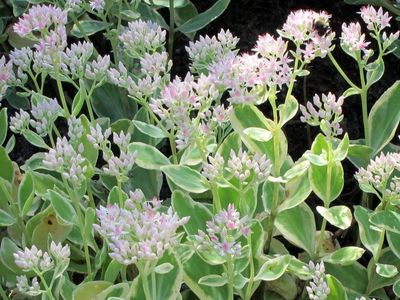Sedum Frosty Morn Info
Sedum plants fill a variety of needs in the landscape. They are drought-tolerant, low maintenance, come in a variety of habits and tones, and thrive in a host of conditions. The plants, found in the stonecrop group, are also vertically appealing since they are the taller, less sprawling members of the family. Sedum ‘Frosty Morn’ brings that statuesque beauty combined with all the other wonderful traits of the genus. The name of this plant is perfectly descriptive. The thick, padded leaves are a soft bluish-green and adorned with icicles of cream along the ribs and edges. Frosty Morn can grow 15 inches (38 cm.) tall with a spread of 12 inches (30.5 cm.). Stonecrop plants die back in winter and return in spring. They start out with sweet, ground-hugging rosettes of leaves before they develop stalks and finally flowers. Bloom time for this variety is late summer to early fall. Tiny, starry flowers are clustered together at the top of a hollow, yet sturdy stem. Flowers are white or tinged pink in cooler climates.
How to Grow Sedum ‘Frosty Morn’
Perennial garden lovers will love growing Frosty Morn sedums. They are resistant to deer and rabbit damage and tolerate dry soil, air pollution, and neglect. They are easy to grow in USDA zones 3-9. You can grow the plants from seed but a quicker and easier way is to divide the plant in fall or early spring, just before the new leaves start to unfurl. Divide stonecrop sedums every 3 years to encourage the best growth. Growing Frosty Morn sedums from stem cuttings is also quite simple. Let the cutting callus over before planting it in a lightly moistened soilless medium. Sedums take off quickly, no matter which propagation method you choose.
Caring for Frosty Morn Stonecrops
Provided you have your plant in a sunny to partially sunny location where the soil drains freely, you will have little problem with your sedum plants. They will even tolerate mildly alkaline up to acidic soil. Frosty morn thrives in either dry or moist conditions but cannot be left in standing water or the roots will rot. Water the plant regularly during the first season to help the plant establish an extensive root system. Use an all-purpose fertilizer in spring. Prune off spent flower heads in fall, or leave them to decorate the plant during the humdrum winter. Just remember to snip off the old flowers well before the new growth emerges.
